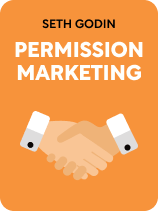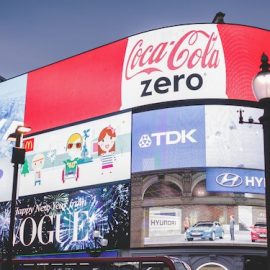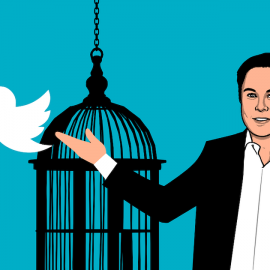

This article is an excerpt from the Shortform book guide to "Permission Marketing" by Seth Godin. Shortform has the world's best summaries and analyses of books you should be reading.
Like this article? Sign up for a free trial here.
What is permission marketing? Why is it more effective than old-style “Interruption Marketing”?
Seth Godin says that the primary advertising method of the 20th century is no longer the most effective approach. He advocates building relationships through what he calls “permission marketing.” He explains what it is and why it’s so much more profitable in today’s brand-saturated market.
Keep reading to understand what permission marketing is as well as the philosophies that are behind it.
What Is Permission Marketing?
Since the turn of the 20th century, the dominant form of marketing has been what Godin calls “Interruption Marketing.” This type of advertising attempts to pull consumers’ attention away from what they want to spend it on. Godin argues that permission marketing is more effective these days.
What is permission marketing? Godin explains that permission marketing involves sending advertising material directly to individual consumers after they request it. Instead of grabbing consumers’ attention while they’re doing something else, promotional material sent through permission marketing is available whenever they want to pay attention to it. For example, if you give your email address to an online shoe store so they can send you exclusive discounts, you’ve opted into their permission marketing campaign.
Permission marketing is the approach small local businesses used before the rise of Interruption Marketing. Consumers became personally familiar with the people who ran the businesses near them. If consumers thought they might need something, they would search out a seller and ask them about it directly, and the seller would gladly help. Today, Godin asserts that the internet makes permission marketing more scalable and profitable than ever before, as you can use email to send messages to as many individual consumers as you need for nearly no cost.
(Shortform note: Since Godin published Permission Marketing, a new and dominant forum for permission marketing has emerged: social media. When users follow a branded account on platforms like Facebook, Instagram, or TikTok, they’re giving that brand permission to show them marketing content. Research shows that out of US internet users from ages 18 to 34, 40% have bought a product they discovered on social media.)
Why Permission Marketing Is Profitable
Interruption Marketing and permission marketing both generate profits by building consumer trust in a brand. However, Godin asserts that permission marketing builds trust in a far more cost-effective way than Interruption Marketing. To explain why, let’s first examine why Interruption Marketing is inherently wasteful and less persuasive than permission marketing. Then, we’ll explore the unique strengths of permission marketing that make it successful and cost-effective.
Interruption Marketing Is Wasteful and Less Persuasive
According to Godin, Interruption Marketing must pay to put their advertisements in front of the same consumer several times before the brand sticks enough in the consumer’s mind to build trust. This is expensive and wasteful. Most consumers will ignore an advertisement the first time they see it. Even if they do notice it, many of them will fail to understand the advertisement’s message right away and will forget about it shortly afterward. Only after multiple exposures can Interruption Marketing influence a consumer to do something.
(Shortform note: In How Brands Grow, Byron Sharp asserts that customers don’t need to understand an advertisement’s message for that ad to be effective. Instead, one main purpose of repetitive advertising is to get consumers to build associations between your brand and cues they encounter in daily life. For example, the golden arches of McDonald’s have become so ubiquitous through advertising that anyone who sees them on the street—or even another curvy “M” that looks like them—will think of McDonald’s and be more likely to think of McDonald’s in the future. This is profitable because when selecting a brand to purchase from, consumers often default to whatever comes to mind first rather than deliberating on which brand is best.)
Additionally, Godin notes, Interruption Marketing is inherently less persuasive than permission marketing materials. Interruption Marketing must be aggressively flashy and sensational to get consumers to notice and remember the brand in as few exposures as possible. This means that, by necessity, they can’t comprehensively communicate the specific benefits of their service or product—the information that would make a consumer want to go out and buy it.
(Shortform note: Research indicates that flashy, sensational advertising may be more effective than Godin gives it credit for. When an advertisement presents something unexpected, emotional, or loud, viewers automatically pay a little bit of attention to it at a semi-conscious level, even if they’re trying to ignore it. Although advertisements prompting this kind of involuntary, semi-conscious attention don’t generate quite as many sales as those that appeal to consumer needs and attract conscious attention, they do generate far more sales than ads that viewers ignore completely.)
Permission Marketing Builds Trust Efficiently
In contrast, Godin explains, permission marketing materials don’t require as many repeated viewings to build familiarity with your brand. Since consumers requested the advertisements, they’ll pay attention to and digest them the very first time they receive them.
Likewise, since the prospective customer has already agreed to pay attention to your message, you don’t have to be as showy and can pitch your product or service’s benefits much more thoroughly than you could in Interruption Marketing. You can directly convince consumers that your brand is reliable, building the same kind of brand trust that Interruption Marketing does but much more efficiently. Since customers tend to buy from brands they trust, this often results in a swift increase in sales.
| Engaging Marketing Builds Trust More Efficiently Although Godin contends that consumers who opt in to your permission marketing will be naturally receptive to your message, other permission marketing experts elaborate that you won’t succeed with just any message. In Dotcom Secrets, Russell Brunson asserts that permission marketing messages must be carefully crafted to convert as many viewers into customers as possible. Specifically, every piece of marketing copy you send must accomplish three things: catch the audience’s attention, illustrate your product’s value, and tell them exactly what to do next. Brunson provides more detailed advice than Godin on how to illustrate your product’s value. Although many consumers would be interested in a simple list of your product or service’s benefits, you’ll get more sales if you communicate those benefits in a compelling way. For instance, weave details about your product or service into a colorful anecdote that illustrates your brand’s unique value. If you’re selling earplugs that are nearly invisible, tell the story of the time your brother went to a metal concert, purposefully left earplugs at home because they looked garish, then got tinnitus. The customer can see how your product would have prevented this painful experience. |
The Permission Marketing Mindsets
Now, let’s cover two key mindsets that undergird permission marketing.
Mindset #1: Your Customer Relationships Are Long-Term Investments
Godin asserts that every consumer relationship you build is a long-term investment. The main goal of permission marketing is to get consumers to trust you more over time. If your brand serves them reliably for long enough, they’ll feel that buying from you is a safe bet and will give you increasing permission to claim more of their time, attention, and money.
For example, if you sell furniture, you could email customers a series of videos over time explaining the effects that different mattresses have on your spine. Eventually, they’ll come to trust your brand because of the consistent value you give them (and simply through repeated exposure). In the future, they’ll be more likely to buy a mattress from you.
In contrast, if you ask for too much permission too quickly, you’ll seem less valuable—and therefore less trustworthy—and push customers away. For instance, if the first email you send to a potential customer begs them to buy a $1,500 mattress before the end of a holiday sale, they won’t yet trust you enough to make the purchase and may unsubscribe to avoid having to read pushy marketing.
| Build Long-Term Relationships Through Excellent Customer Service According to Tony Hsieh in Delivering Happiness, the surest way to build long-term trusting relationships with customers is to offer stellar customer service. Customers will return to your brand again and again if you give them an impactful customer service experience, yielding more value over the long run even if you sacrifice short-term profits. Hsieh says that his shoe company, Zappos, achieves this kind of service by establishing unique guidelines for its customer service call center. Its call center doesn’t time calls with customers, to avoid pressuring representatives into rushing their service. It doesn’t use call scripts, instead encouraging representatives to have honest, human conversations with customers. Zappos also doesn’t force representatives to try to make new sales while on call, as many companies do, instead letting them focus on the customer’s problem. Companies that try to sell to customers looking for support are arguably asking for too much permission too soon. If a customer already has a problem with your brand they’re trying to solve, their trust in you is in jeopardy. Asking them for more money will only further unravel their trust. Instead, these companies would be better off selling to satisfied, loyal customers who have developed trust in the brand over months or years. |
Mindset #2: Personal Data Lets You Offer Personalized Service
Godin recommends asking for permission to gather personal information about consumers so you can better serve their needs. Using this data, you can personalize the messages you send to each consumer and ensure that you only make offers that are truly valuable to them (unlike other companies that spam them with Interruption Marketing for things they don’t want).
Make sure not to sell or trade this personal data to another company. Although you could profit from this in the short term, Godin asserts that when your customers discover you’ve allowed other companies to use their data without their permission, they’ll conclude that you don’t have their best interests in mind. You’ll lose their trust, and they’ll take their business elsewhere.
| Cookies and Data Privacy on Today’s Internet One of the primary ways online companies collect personal information from their users is through cookies—local files that allow websites to track your online activity and information. Practically since the dawn of the Internet, companies have used cookies to collect personal data without explicit permission, persistently drawing concerns over privacy. In particular, critics protest third-party cookies, which allow companies to track users’ activity across websites that don’t belong to them. In Permission Marketing, Godin (in 1999) correctly predicts that targeted advertising using third-party cookies will quickly become the dominant form of advertising on the web. However, he arguably overestimates how much consumers would distrust companies that sell their data and abandon those that did so. One 2022 study found the average US resident has their online activity shared with a third party 747 times every day—yet most of us continue to trust big tech companies at least enough to use their products every day. Responding to privacy concerns, some companies have taken steps to limit the trade of personal data. Third-party cookies have been blocked by default by web browsers Safari and Firefox, and Google Chrome is set to follow suit sometime in 2024. However, some companies are developing cookie alternatives for marketers that still don’t align with Godin’s vision for voluntary data collection. For instance, Google’s Topics API is a tool marketers can use to show personalized ads to users interested in certain topics, without those advertisers having access to specific user data. Critics have noted that this tool still tracks consumers without explicit permission and leaves them largely in the dark about what personal data is being shared with whom. |

———End of Preview———
Like what you just read? Read the rest of the world's best book summary and analysis of Seth Godin's "Permission Marketing" at Shortform.
Here's what you'll find in our full Permission Marketing summary:
- Why common intrusive marketing methods don't work well anymore
- How to build a loyal customer base that wants to see your marketing
- Three steps to building and profiting from a permission marketing campaign






